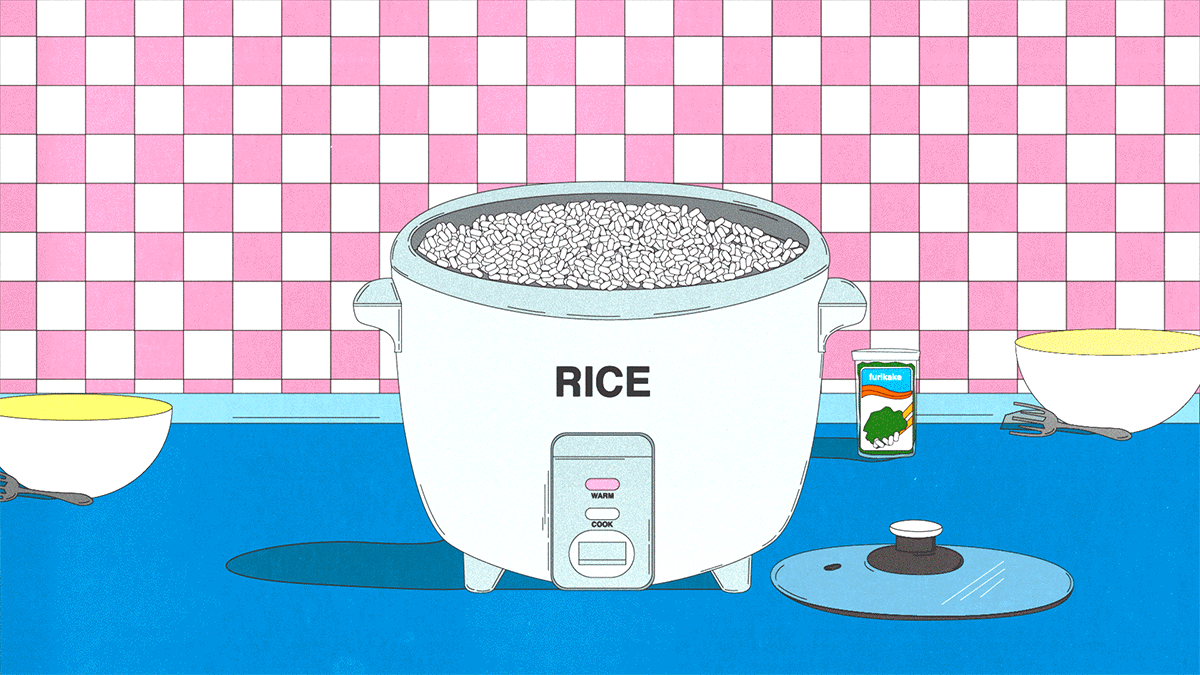
Inspired by Hainanese chicken rice (and Colonel Sanders), a better bowl of rice can be yours with the flip of a switch.
For most of my life, my rice routine has remained the same. Measure out a cup of short grain rice, rinse it three to four times until the water runs clear, fill the Sanyo brand rice cooker pot with water until it reaches my first knuckle, cover it, then flip the cook switch on. Fluff it up with a rice paddle once it’s done, portion in bowls, and shovel it into my mouth between bites of soy sauce–glazed eggplant and fermented tofu simmered with Chinese cauliflower.
But after cooking most of my meals at home for nearly a year now, burnout feels inevitable. It’s become as rote as washing vegetables or soft boiling an egg. Even though I grew up eating plain rice with most of my meals, I couldn’t help but wonder if there was more I could be doing with it to break up the monotony without catapulting each meal into a multicourse hullaballoo.
Looking back on more ambitious home cooking projects I readily tackled last spring, when it all felt more novel, the method to flavor the rice in Hainanese chicken rice lit a spark. Slices of succulent poached chicken are paired up with aromatic Jasmine rice cooked in its own freshly made stock and toasted with garlic and rendered chicken fat—making use of every part of the chicken and upholding the purity of its flavor.
Even without a whole chicken at my disposal, the method taught me small techniques to incorporate flavor at every stage, and it certainly doesn’t have to be eaten exclusively with poached chicken. Adding garlic sautéed in leftover chicken schmaltz (though you could certainly stock your fridge with a store-bought jar) infused it with a warm, allium-heavy richness that could sit beneath any crisped-up slice of Spam. Toasting raw rice in a skillet before cooking it in water gave each grain a subtle whiff of smokiness that added new dimension to coconut milk–based curries. Using up a half carton of chicken stock or vegetable stock as the rice’s cooking liquid not only cleared out my fridge, it gave the grain more of a presence against flakes of tuna confit.
When I started to think about it more, these subtle upgrades were hiding in plain sight. Traditional Chinese clay pot rice recipes can be adapted for the rice cooker, allowing dried shiitake mushrooms—loaded with umami—and fatty links of sweet lap cheong to cook with the rice, as it absorbs its juices at the same time. Rice dishes made in another variation of clay pots, donabe, follow suit—and, taking a page from Naoko Takei Moore’s cookbook Donabe, every recipe has its own flavor-melding techniques that are just as suitable for a modern rice cooker. Layer smoky dashi with classic chicken stock, lean on aromatics like sansho pepper or julienned ginger to perfume the entire pot, let the juices from deboned chicken wings and flakes of salted salmon drip onto a bed of grains.
Even leftover KFC became an unlikely source of inspiration—thanks to Japan’s obsession with and the internet’s swift adoption of reheating leftover chicken parts in a rice cooker with rice, adding a few tablespoons of soy sauce, and swapping water for chicken stock. While the chicken’s crisp exterior won’t be revived in a rice cooker, the resulting rice that’s savory and slightly enriched with chicken juices makes up for it.
These may not be revelatory ways to cook, nor am I the first to endorse the many benefits of owning a rice cooker. But it does help to see the countertop workhorse in a new light—and even better when it’s as easy as flipping the “on” switch.
LET YOUR RICE COOKER DO THE WORK
- Replace water with any flavorful stock (dashi, vegetable, chicken, beef).
- Add in a handful of sliced aromatics or spices (ginger, garlic, scallion, leeks, crushed Sichuan peppercorns).
- Throw in your leftovers (slices of roasted chicken or fish work especially well, as they won’t dry out or get too tough after being steamed).
- Go the fried chicken route, topping the rice with a layer of KFC or Popeyes and adding a splash of soy sauce to your cooking liquid.